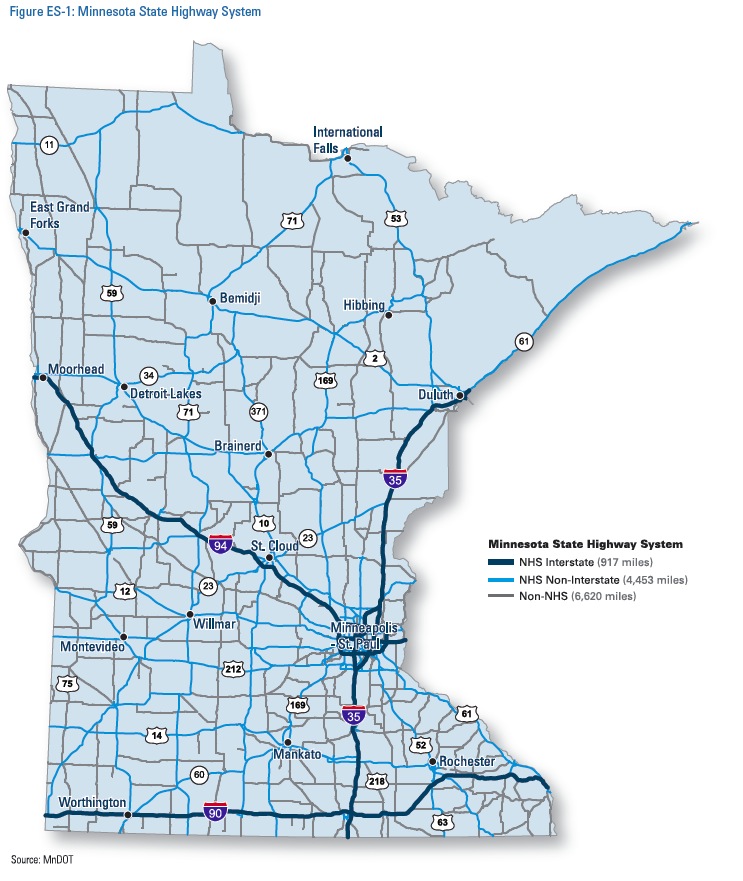MINNESOTA GO
Executive Summary
Overview
Minnesota’s 12,000-mile state highway system plays a critical role in supporting the state’s economic vitality and quality of life. Economic vitality, as well as quality of life, depends upon a strong, well-connected transportation network. To compete economically and to position Minnesota for the future, MnDOT needs to maintain the state highway system. The size and the age of Minnesota’s transportation system demonstrate the scope of the state highway system’s investment need:
- 50 percent of state highway pavements are more than 50 years old.
- 35 percent of state highway bridges are more than 50 years old.
- Compared to other states, Minnesota ranks in the bottom half for Interstate pavement condition (38th out of 50).
- Minnesota ranks 9th nationally for bridge condition on state highways.
The Minnesota Department of Transportation (MnDOT) is directly charged with constructing, operating, maintaining, and managing this system, which is 74 percent of the State’s capital assets. The Minnesota 20-Year State Highway Investment Plan (MnSHIP) is MnDOT’s vehicle for deciding and communicating capital investment priorities for the system for the next 20 years. MnSHIP is a fiscally constrained plan, meaning its planned expenditures must align with expected revenues, which total $18 billion. Meanwhile, the projected transportation needs on the state highway system total $30 billion.
MnDOT must account for many factors when setting priorities, including federal and state law, system conditions, and public input. The result is a set of investment priorities that vary over the next 20 years. MnDOT’s priorities for the next 10 years balance preservation of existing infrastructure with investments in safety, new connections for multiple modes of transportation, and other projects that advance economic development and quality of life objectives.
However, investments in the second 10 years focus almost exclusively on preserving existing infrastructure. Despite this focus, the number of roads and bridges in poor condition will more than double and perhaps even triple within 20 years. Given the projected $12 billion funding gap, there will be many unfunded priorities within the 20-year horizon.
Minnesota’s State Highway System
Minnesota’s state highway system includes the National Highway System (NHS) as well as other important roads. The NHS includes Interstates, most U.S. highways, and other principal arterials (see Figure ES-1). Like most transportation systems, state highways are aging and require a significant level of investment to simply maintain existing infrastructure.
The importance of the state highway system is demonstrated by its use. It comprises just 8.5 percent of Minnesota’s total roadway miles, yet carries almost 60 percent of the miles traveled as well as the majority of the freight being moved on Minnesota’s roads. It connects people to school, work, healthcare, and recreational activities. It is the system businesses rely on to move their goods to store shelves; raw materials to manufacturers; and agricultural products to processors and markets throughout the state, country, and world. The multimodal network serves many transportation users—passenger vehicles, freight carriers, transit providers, bicyclists and pedestrians—and connects them to other transportation options and networks.
View full version (dot.state.mn.us): Minnesota 20-Year State Highway Investment Plan
About Minnesota GO
www.dot.state.mn.us/minnesotago
“The Minnesota Department of Transportation launched the Minnesota GO visioning process to better align the transportation system with what Minnesotans expect for their quality of life, economy and natural environment…The effort is based on an understanding that transportation is a means to other ends, not an end in itself. It also recognizes that infrastructure is only one of many elements necessary to achieving a high quality of life, a competitive economy and a healthy environment.”
Tags: Minnesota, Minnesota Department of Transportation, Minnesota GO, MN, MnDOT, MnSHIP







 RSS Feed
RSS Feed